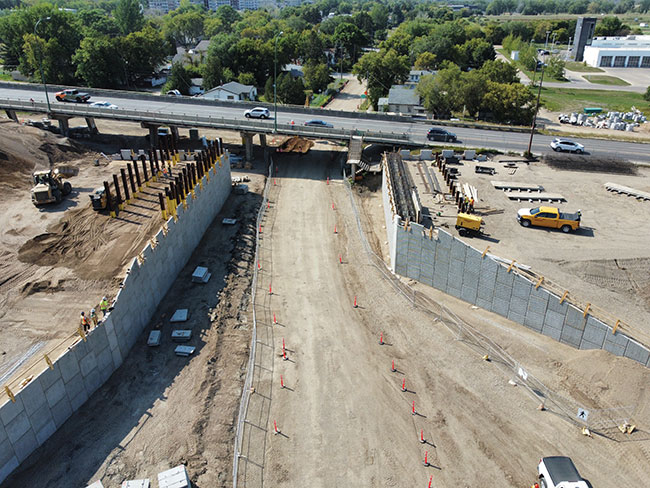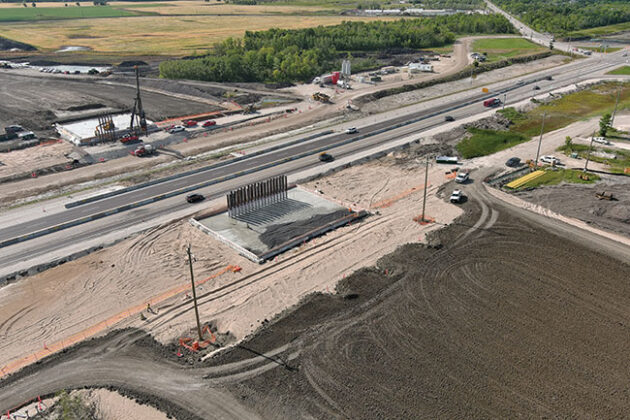
Features
Investments
Projects
Roads & Paving
Infrastructure injections coming to Manitoba’s southwestern corridor
Manitoba’s plans to invest across the Brandon and Westman regions
July 3, 2023 By Jack Burton
 (Photo credit: Government of Manitoba)
(Photo credit: Government of Manitoba) In March, the Manitoba Department of Transportation announced a robust, $50-million plan to target road and highway development surrounding Brandon and the Westman regions. These projects, as part of their overall Multi-Year Infrastructure Investment Strategy, are just one piece of the province’s goal for a healthy infrastructure network connecting all of Manitoba.
A majority of the investment is going toward the Trans-Canada Highway; with a surface rehabilitation planned over the 1.6 km between Provincial Trunk Highway (PTH) 10 and PTH 1A, 0.3 km between the west and east junctions of PTH 10, a stretch between PTH 25 and Provincial Road 270, along with PTH 10 from the Trans-Canada Highway to PTH25; totalling $29.2 million.
The plan also focuses on structure replacements on the Trans-Canada Highway’s westbound lanes at Willow Creek West Branch, and for the westbound lanes at South Boggy Creek for a total of $16.5 million, in addition to $1.36 million in work planned to occur on PR 457 between PR 110 and PR 468.
As the province’s second largest urban centre, it follows that the projects aim to build out provincial infrastructure not only beyond the Winnipeg corridor, but over the long-term, and also create another commerce centre that can mirror the capital’s economic growth on the western end of the province.
“Our Premier wants economic development in every corner of this province, and that includes the Westman region,” said Doyle Piwniuk, Manitoba’s Minister of Transportation. “As the second largest city and second largest commerce area in the province – in the region, there’s almost a quarter million people that actually use Brandon as a regional centre – we want to ensure the best for the highways that lead into Brandon.”
In the case of the Westman Region, Piwniuk believes that the industries are already there – including the hog industry, oil and gas, and the province’s first potash mine in Russell, set to begin production this summer – it’s just a matter of updating and installing the proper infrastructure to accommodate them.

By communicating budgets effectively, Minister of Transportation Doyle Piwniuk hopes that contractors across the industry will be best prepared for what is needed for future projects.
“Right now, it’s important that we invest in our highways so that we can show outside investment that we’re here, and we’re open for business,” said Piwniuk. “There’s a lot of maintenance needed to rebuild these highways, and that’s what we’re doing. We’re doing that in every part of the province, but especially in the Westman, because there’s a big opportunity when it comes to agriculture, oil and gas, and just overall economic
development.”
A key focus of this initiative, Piwniuk shared, is the forward-looking focus of these projects. For him, it’s about more than just accommodating the current economy of the region on an infrastructural level – it’s about having the foundation to support the growth and investments in these sectors that these upgrades will bring for years to come.
“You know what they say: the best time to plant a tree was 20 years ago, and the next best time is now,” he said. “So, this is what we have to focus on: how do we move our trade corridor and look at the future of that area, especially through Brandon, as starting to plant that seed right now, and foster it, too, so that we can actually have a freeway going through all of Manitoba?”
Naturally, as these industries grow, so will the movement of goods and commerce between these markets – meaning the simple, future-proof way of achieving this goal begins with the highways.
“We’re looking at long-term planning for the Trans-Canada Highway, because again, it’s going to basically become a freeway in the future, and we want to start working and planning for that,” he said.
In addition to unlocking the full economic potential of the area, these plans are also aimed at optimizing quality of life for residents, specifically in Brandon, with goals of reducing traffic congestion and increasing safety for pedestrians and cyclists surrounding the urban centre’s roadways.
The beginning stages of this significant initiative is already in motion, with the government currently in talks with the City of Brandon on the direction of the plan, before moving into the consultation and design phase.
Regarding the overall timeline, Piwniuk said that “it’s going to take a number of years to do the consultation and designs, and once we have that, we’ll go out there and start the tendering process, which will allow any contractor to bid on the opportunity to do that range of projects.”
While the project is aimed at extending economic activity across the province, the government is also looking at it as a means of bolstering Manitoba’s heavy construction sector, strengthening the relationship between industry and government.

Manitoba’s Minister of Transportation Doyle Piwniuk says it is important to invest in highways to show outside investment that the province is “open for business.”
“When it comes to Manitoba Heavy Construction [Association], they requested that we go to a five-year budget, so that they’re properly informed and prepared for what’s to come,” Piwniuk said. “If they know what is coming, then we can work together to make sure that we bring this province, and the opportunity of investing in infrastructure, forward.”
Part of the changes in how the public and private construction industries in the province operate and interact are in reaction to a number of delays and setbacks to projects awarded over the last several years. By communicating budgets effectively, Piwniuk hopes that contractors across the industry will be best prepared for what’s needed for the incoming wave of projects.
“We don’t want to leave money on the table when it comes to our budgets,” he said. “A lot of projects have been tendered and awarded, but have yet to be completed. So, this year, we want to make sure that when it comes to the five-year plan, we work with the private sector and contractors to make sure that when we have a five-year budget, it allows companies to invest in the human resources and equipment now, to get ready for what’s to come in the future.”
These delays, Piwniuk noted, were often no fault of the contractors themselves, but rather the unprecedented flooding that numerous regions across the province faced in 2022.
“Last year was perhaps the second worst flood in provincial history, because it wasn’t just that we had it in one region – it came in every direction,” Piwniuk explained. “We had staff, we had contractors, going all over the place, just to repair the highways that were damaged in the 2022 flood.”
While the conditions created by this incident added difficulty for projects to be completed on time, the flooding illuminated several obstacles, on both an infrastructure and policy level, worth being mindful of as they take a renewed focus in overall provincial infrastructure.

The upcoming projects are part of the province’s Multi-Year Infrastructure Investment Strategy.
Photos: Manitoba Department of Transportation.
“Sometimes, when it comes to a crisis like a flood, it results in an opportunity for change when it comes to how we look at how things work,” Piwniuk said.
He highlighted a move away from culverts, and their inefficient modes of maintenance, and toward bridges as one infrastructure lesson the province has put into action after the insights provided by the flooding.
“It’s the definition of insanity, doing the same thing over and over, and trying to get different results,” he said, regarding the government-mandated maintenance on flooded culverts and the resources it requires. “So, what we’re doing now, we’re drawing on a number of examples from last year’s flood that we’ve used as opportunities to put in bridges, to be better prepared should we have major floods.”
The province has learned numerous lessons, whether from current infrastructure, regional industries, private sector relations, or natural occurrences, that have all informed and contributed to the current vision that the government has for unlocking the full economic potential of the province, both now and for years to come.
“Before, we felt with the previous government that we were forgotten in the Westman Region,” said Piwniuk. “And now, this is our time to prosper: we need to put Brandon in focus, and make sure that economically, we’re working together to attract that outside investment because when Brandon grows, the whole Westman, and in turn the whole province, grows along with it.”
Print this page